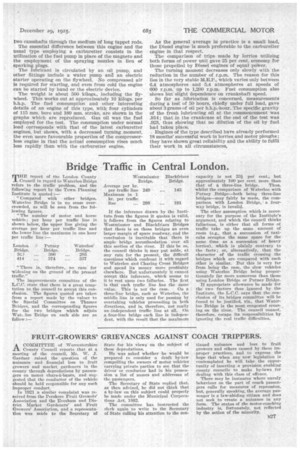Bridge Traffic in Central London.
Page 11

If you've noticed an error in this article please click here to report it so we can fix it.
THE report of the London County Council in regard to Waterloo Bridge refers to the traffic problem, and the following report by the Town Planning Institute is quoted ;—
"Compared with other bridges, Waterloo Bridge is in no sense overcrowded, as will be seen from the following figures.
"The number of motor and horse vehicle, ..1 per hour per traffic line is shown below, the upper line giving the average per hour per traffic line and the lower line the maximum in one hour per traffic line'—
London Putney Waterloo' Bridge. Bridge. Bridge.
30 300 ... 285 414 ... 374 337 " There is, therefore, no case for widening on the ground of the present traffic."
The improvements committee of the L.C.C. state that there is a great temptation to the council to accept this conclusion. The figures quoted are taken from a report made by the valuer to the Special Committee on Thames Midges, and the corresponding figures for the two bridges which adjoin Watt loo Bridge on each side are as follow:— 'Westminster Blackfriars Bridge. Bridge. Average per hr.
per traffic line 249 143 Maximum in 1 hr. per traffic
line 298 191
If the inference drawn by the Institute from the figures it quotes is valid, it follows from the figures relating to Westminster and 131ackfriars Bridges that there is on those 'bridges an even larger margin of spare roadway, and the conclusion is inevitable that there is ample bridge accordmodation over all this section of the river. If this be so, the council thinks it may put aside, at any rate for the present, the difficult questions which confront it with regard to Waterloo and Charing Cross Bridges and spend its money more profitably elsewhere. But unfortunately it cannot accept this inference, which seems to it to rest upon two fallacies. The first is that each traffic line has the -dame value. This is not the case. On a three-line bridge, such as Waterloo, the middle line is only used for passing by overtaking vehicles proceeding in both directions, and is, therefore, not really an independent traffic line at all. On a four-line bridge each line is independent, with the result that the maximum capacity is not 381 per; cent., but approximately 100 per cent, more than that of a three-line bridge. Thus, whilst the comparison of Waterloo with Putney Bridge—both being three-line bridges—may fairly be made, the comparison with London Bridge, a f ourway bridge, is invalid.
The other assumption which is necessary for the purpose of the Institute's argument, and which the council thinks fallacious, is either that all forms of traffic take up the same amount of room (e.g., that a succession of taxicabs occupies the same space for the same time as a succession of heavy lorries), which is plainly contrary to the facts ; or, alternatively, that the character of the traffic crossing the bridges which are compared with each Other is similar. But this is very far from being the case, the slow vehicles using Waterloo Bridge being proportionately far more numerous than those using London Bridge or Putney Bridge.
If appropriate allowance be made for the two factors thus ignored by the Institute, the L.C.C. says that the conclusion of its bridges committee will be found to be justified, viz., that 'Waterloo Bridge is the most congested crossing on the river. The council cannot, therefore, escape its responsibilities by ignoring the real traffic difficulties.






























